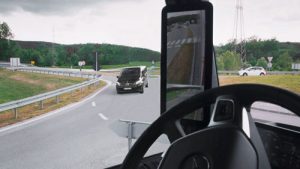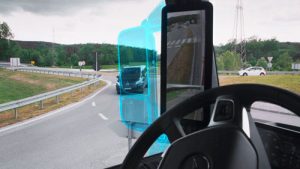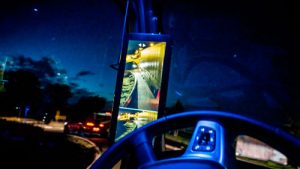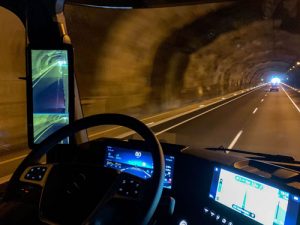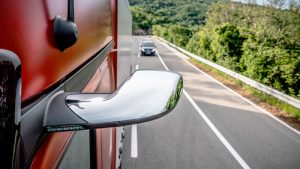The new camera tech aboard the Mercedes-Benz Actros has changed the way trucks will be looked at hereafter.
Story by Bhushan Mhapralkar
Extending a significant gain in the safety of those on board and those in the surrounding, the new Mercedes-Benz Actros has come to flaunt a new camera technology on board. What was being talked and experimented upon until have has to come to reach a certain commercialisation level on the Actros in the form of cameras positioned on the roof frame. The display of these cameras is a HD unit on the inside of the A-pillars of the Daimler’s flagship offering. Amounting to significant gains in terms of safety on account of higher visibility and lesser blind spots, the new camera tech on board the Actros has made those large elephant-ears like rearview wide-angle mirrors redundant. The result of this is a gain in aerodynamics and a subsequent decrease in fuel consumption. The camera technology, termed as MirrorCam, provides the driver of Actros an unobstructed view of the rear and the near surrounding area.
Providing a distinct advantage at junctions and when manoeuvring past tight corners or narrow lanes, MirrorCam saves the truck driver the need to look as far to the right or left to see traffic to the rear. If the conventional mirrors are mounted in a fixed position, and can lead the driver to lose sight of the end of the semi-trailer when cornering, the MirrorCam swivels the image of the camera mounted toward the inside of the bend. The chances of driver losing sight are drastically minimised. The end of the trailer is in view even when manoeuvring past the corner. Set for standard semitrailers, but with the capability to individually regulate the swivel, MirrorCam marks a highly evolved technology in terms of adaptability. The swiveling happens on modern trailers automatically when they transmit their geometric data to the towing vehicle! In addition, the driver can move the swivel radius manually in the door operating unit using the side selection button and the four-way rocker switch.
Advantage MirrorCam
Capable of reducing the fuel consumption by as much as 1.5 per cent on the virtue of the absence of the large elephant-ears like rearview wide-angle mirrors, MirrorCam also offers the advantage of relieving the driver of the worry of misty or dirty mirrors and side windows. In trucks, due to the size of the mirrors and the windows, and the difficulty in reaching them, their misting or getting dirty has always been a problem drivers have been complaining about, especially in dusty terrains and in snowy or acute winter conditions. The high positioning of the cameras of the MirrorCam on the Actros make them fairly immune to occurrences of them getting dirty or inefficient in their function. Above the camera lens is a small roof. There’s a special coating in addition. The digital transmission of the image to a display in the cab means misting and dirt could hardly affect at all. Of particular help during cold or damp days is the fact that the cameras come with an automatic heating property. They are heated when the temperatures fall below 15 degrees Celsius.
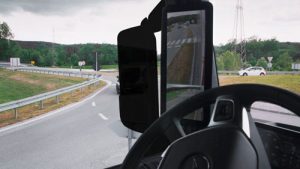 Like the reverse or parking cameras in most cars, the MirrorCam technology has distance indicator lines on the display. These help the drivers to estimate the distances behind the truck, and are in the form of three fixed lines in parallel, and one above the other rather than the horizontal parallel lines found on most car reverse camera system. The driver of the Actros can adjust these lines to precisely mark the end of the vehicle before starting a journey. Used in combination with the information shown in the displays by the assistance systems, the driver better assess three typical situations – judging if there is sufficient distance to move out to the left, the distance at the rear of the vehicle when manoeuvring, and is it possible as well as safe to merge to the inside lane after overtaking. The beauty of the MirrorCam given the three typical situations mentioned above is its ability to work under different lighting conditions. The high light transmission of the cameras provides the system with an advantage in residual light situations. In situations at dusk, that is. Often described as twilight conditions where it could be very difficult to judge distances and situations, jeopardizing safety thus.
Like the reverse or parking cameras in most cars, the MirrorCam technology has distance indicator lines on the display. These help the drivers to estimate the distances behind the truck, and are in the form of three fixed lines in parallel, and one above the other rather than the horizontal parallel lines found on most car reverse camera system. The driver of the Actros can adjust these lines to precisely mark the end of the vehicle before starting a journey. Used in combination with the information shown in the displays by the assistance systems, the driver better assess three typical situations – judging if there is sufficient distance to move out to the left, the distance at the rear of the vehicle when manoeuvring, and is it possible as well as safe to merge to the inside lane after overtaking. The beauty of the MirrorCam given the three typical situations mentioned above is its ability to work under different lighting conditions. The high light transmission of the cameras provides the system with an advantage in residual light situations. In situations at dusk, that is. Often described as twilight conditions where it could be very difficult to judge distances and situations, jeopardizing safety thus.
Brighter is better
If it would be difficult for the driver of a semi-trailer to judge distance and what is behind the truck or on the near and far side in a twilight time zone, the MirrorCam displays show an image that is much brighter than the natural light. The driver thus receives better information about his surroundings than he would from a mirror. What is more advantageous is the adjust-ability of the brightness in regards to the prevailing light conditions in a step-less manner. The driver of the Actros is not dazzled thus. Working on open roads, and in tunnels, MirrorCam camera technology on the Actros is yet to gain in conditions when it is completely dark. When it is completely dark outside, the MirrorCam shows areas illuminated by the vehicle itself – just like a conventional mirror. Development in the direction of providing the driver with a good image at night is on. The maximum image information stage that the developers have reached until now is beset by a little image noise. Efforts are being made to ensure that there is as less noise as possible. If adjusting the brightness of the display help? Given the varying perception, weather conditions and times of day, there could be a good reason to adjust the brightness of displays. However the factor of noise has got the developers of the technology to look at newer avenues of overcoming the challenge.
Brightness adjustment
In conditions other than complete darkness, the displays could provide the driver of the Actros with a good deal of advantage by adjusting their brightness. This is done simply via the right-hand touchscreen display or the multifunction steering wheel. If necessary, the brightness of the right-hand and left-hand display can be adjusted differently. A virtual slide controller can be accessed for this to be done, via the menu, ‘Display and Brightness’. In terms of clarity, drivers may find the monitor images to be not as clear as their smartphones. That is not exactly the case however. It is because, what the truck drivers are used to in the way of looking in a mirror is more decisive than the pixel density. With a screen diagonal of 15.2 inches (38.6 cm), MirrorCam tech corresponds approximately with the previous mirror form. In doing so, the distance and speed of a vehicle to the rear can be estimated. It can be estimated using size and change in size. In case of the comparison of the display with the smartphone screen, it needs to be considered that many modern smartphone displays show a pixel-per-inch ratio that is often beyond the resolution power of the user’s eye. Also the device lies in the user’s hand, so that the distance to the eye is very small. In case of MirrorCam tech, the displays are at a considerable distance. This makes it possible that the eye could miss out on some extremely finite details making it look like the displays are lacking somewhat in clarity.
Given the fact that the pixel-per-inch ratio shown by many modern smartphones is often beyond the resolution power of the eye, a pixel number similar to that of a smartphone is not at all necessary for MirrorCam. Fitted on a truck model that was judged by the Europe-based ITOY consortium as the International Truck of the Year, and of which CV magazine is the India representative, MirrorCam tech has garnered a highly positive response from the trucking community and others for a big reason. Acting as a central safety system that is designed for reliability, MirrorCam is made highly promising on the Actros by the fact that it has successfully completed all of the specified registration procedures. As it stands today, it has left the smartphones behind with its ability to be intelligent in the application it is meant to accomplish. Accounting for the fact that the area that can be seen changes in the case of mirrors with every change of driver, MirrorCam tech ensures that irrespective of which driver is at the wheel, he or she sees the same image.
Defying physics?
Much attention has been paid to overcome the simple physics that applies to convention mirrors – the angle of incidence equals the angle of reflection, while developing MirrorCam tech. The driver of the Actros will thus see the same image, and in every position, courtesy the camera and screen combination as well as ability to set individually the field of vision using the door operating unit. If the driver shifts the field of vision so far that legal stipulations are no longer fulfilled, a note on the display indicates the same immediately. The mirrors would never be able to indicate the same. By pressing and holding the function button, MirrorCam quickly returns to standard setting. Engineered to provide the same results to the driver wearing glasses, MirrorCam tech will take some time getting used to though for such drivers. Given the new angle of vision and distances, it is also possible that some drivers would initially find it difficult to reverse in a straight line using the technology. The fact that MirrorCam offers two views when manoeuvring backwards could help.
In the standard setting the large main display shows the area directly around the truck and the lower section the further surroundings. This view proves its value particularly when the driver reverses around a bend. However if the driver is reversing in a straight line, it is often better to deactivate this function. This is simply done by using a button in the door operating unit. Taking some time to get used to, MirrorCam offers a number of possibilities in comparison to mirrors. Cameras located somewhat further beyond the outer edges of the vehicle than mirrors ensure that they can help with a better view than the mirrors when reversing in a straight line. Initially, the driver could simply glance alternately at both displays like he would do in the case of mirrors. An amount of experimentation when the Actros was launched revealed that some drivers, used to looking at rear view mirror systems, felt that they were driving at an angle after looking at only one of the MirrorCam displays while reversing whereas they were actually driving in a straight line. Made interesting by the fact that MirrorCam and Sideguard Assist work together, the same displays work for the two.
While Sideguard Assist supports drivers by drawing their attention to stationary or moving objects and persons in the monitored area to the far side of the truck when there is a risk of collision. The MirrorCam display shows these warnings in visual form. The driver thus receives all information bundled together in one place. Working even when the engine is witched off, the driver of the Actros can activate the system for two minutes using a switch by the bed and on the co-driver’s side. The area surrounding the vehicle is thus in view, and indicates of any suspicious activity involving the truck or its load. The system starts automatically when the door is opened, and makes it safe to exit the vehicle at all times.




